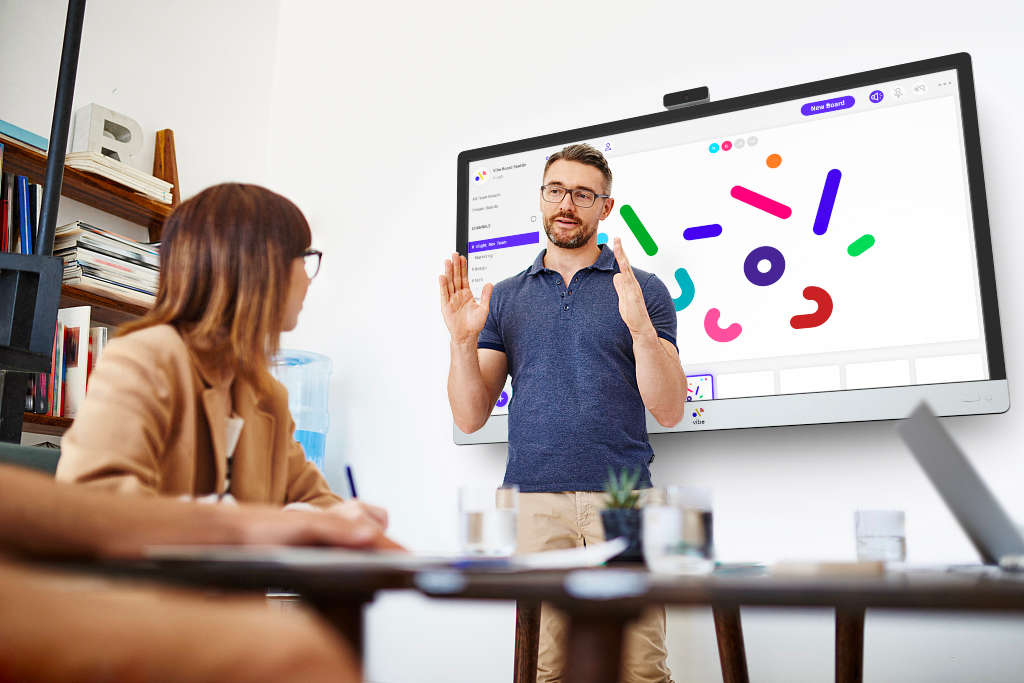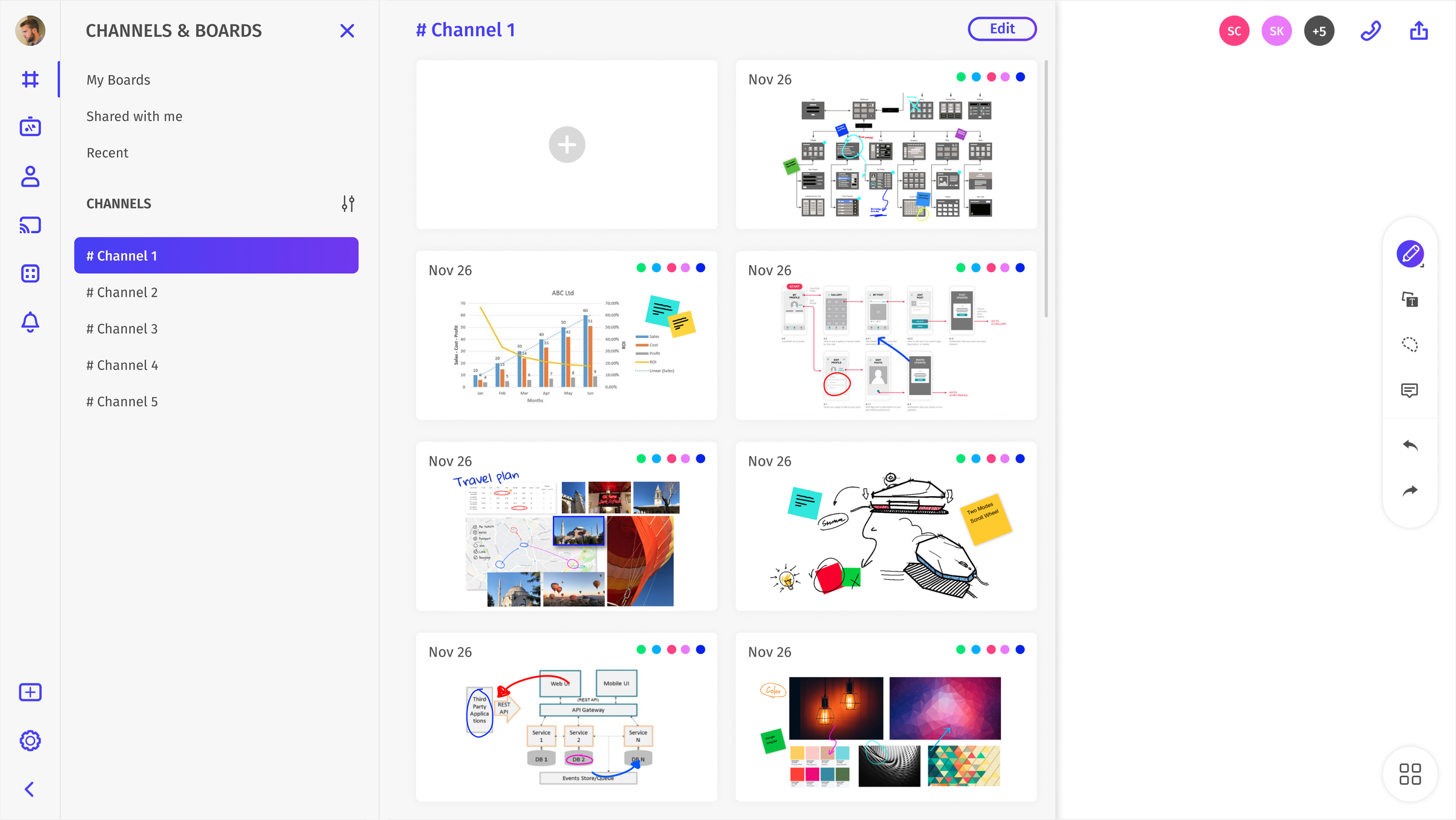The whiteboard has been a popular medium for problem solving since its early introduction to the workplace in the 1990s. So popular, in fact, that whole modes of collaboration—collectively referred to as "whiteboarding"—have sprung up around it.
Whiteboarding has always been around in some form or another. Chalkboards are the most obvious predecessor to the whiteboard, but so are handwritten plans on cocktail napkins and envelopes, or little diagrams and doodles that eventually develop into incredible products. The digital whiteboard is only the latest, greatest way to bring your vision to life.
Whiteboarding helps us solve problems, visualize ideas, and define workflows. This process allows teams to structure their thoughts in a public setting where they can generate actionable feedback. The smart whiteboard is much more than just a place to scribble out notes—it’s also a critical element in the session, a place for mapping and brainstorming.
What is whiteboarding?
At its most basic level, whiteboarding is using a whiteboard to organize and document ideas. This can involve a literal whiteboard hung on the wall or a freestanding easel with a pad of paper. The modern solution is a digital whiteboard that can take notes, translate handwriting into legible text, auto-save your sessions, and more (i.e. the Vibe Board).
But there’s so much more to whiteboarding than simply writing notes. It can refer to anything from collaboration in classrooms to conducting sales presentations to displaying skills on the spot for a job interview.
 Presenting in front of a Vibe interactive whiteboard.
Presenting in front of a Vibe interactive whiteboard.In this guide, we’ll discuss how using a digital whiteboard to visualize and document ideas can transform your ideation process. Here we go!
Related: Digital Whiteboards: the 11 Best Reasons to Invest
Successful whiteboarding use cases
The whiteboard is as much a source of inspiration as it is a place for tracking it. A whiteboard can serve as the organizational locus for a brainstorming session or the place where the abstract threads and visions swirling in your imagination take shape and come to life.
Presenting ideas and getting feedback
Whiteboarding can create a valuable competitive advantage for sales teams. For example, the ability to illustrate pain points and follow them to resolution gives prospective clients something visual to grasp onto during a presentation. Rather than simply saying, "Our product does X," you can guide your prospect through the process, highlighting value and empowering them to participate in your presentation.
For your account managers and customer-facing teams, whiteboards can lead to more productive meetings, organize recaps, drive collaboration, and much more. Organizing everyone’s thoughts in one place can keep meetings on track and ensure that you’re addressing key touchpoints.
Visualizing complex problems
Using verbal communication to describe complex systems or define workflows isn’t ideal for every setting. In many instances, a simple diagram can make a concept easier to grasp. Using graphic representations of abstractions can give people the concrete foothold they need to develop a firm understanding. For UX designers, this visual brainstorming component is indispensable.
 Whiteboarding UX design on a Vibe Smart Whiteboard
Whiteboarding UX design on a Vibe Smart WhiteboardRelated: How to Use a Whiteboard to Lead a Great Brainstorming Session
Boosting internal productivity
Sometimes, it’s the little things that inspire productivity. For avid list makers, few things are as satisfying as the physical action of crossing an action item off. Whiteboards can serve as active sites for task planning, but they can also serve to document wins.
Connecting all team members
Digital whiteboards are an effective interactive tool for engaging and connecting team members during a whiteboard session. Because everyone can access and contribute to the screen, it creates an innovative atmosphere that sparks discussion and collaboration.
Traditional whiteboards can be challenging to read (or even see) during a video conference, making them ineffective for remote teams. An interactive whiteboard allows remote participants to view and contribute efficiently to the shared space, enhancing the meeting’s communication capabilities.
Whiteboarding mistakes to avoid
Whiteboarding isn’t a recipe for success all the time. Without proper planning, the whiteboard can create confusion, constrict ideation flows, and even lead to your great ideas getting erased out of existence. Thankfully, the fixes for these problems are usually pretty straightforward.
Here are a few instances where whiteboarding can become a hazard, along with easy solutions to remedy the situation:
Focus isn’t clearly defined at the start
A study found that 43% of participants felt meetings became ineffective when there were unclear actions, which lead to confusion. Productive meetings focus on a specific purpose with an agenda that defines and drills into key specifics relating to the meeting’s purpose.
Without a clear and defined focus, your team may end up trying to solve several different problems at the same time. That’s why whiteboarding sessions need a prepared facilitator to guide everyone toward an established goal. Before you start brainstorming and problem solving, your facilitator should define what problem you’re resolving during the session and set an itinerary for the meetup.
Use the interactive whiteboard to keep the team on task by writing the meeting’s purpose at the top of the canvas as a reminder. You can also create separate spaces on the board for capturing ideas and solutions. When everyone can maintain a clear focus, they’ll contribute more constructively.
One way that we love to assign organized spaces on the board? Divide the whiteboard into a problem space (where the your team can define and analyze the problem) and a solution space (where you solve the problem).
Another valuable way to keep everyone on track is to set up a "parking lot" on your whiteboard. This space is where valuable ideas that are outside the scope of the current session can wait for later discussion. That way, people feel like they are heard—and their ideas don’t get lost in the mix—while everyone stays focused and on task.
 Save various templates and project boards in Vibe
Save various templates and project boards in VibeIdeas are cluttered and disorganized
When whiteboarding sessions are flowing with ideas, sometimes the board can become cluttered and disorganized. A digital whiteboard enables you to create logical categories by dissecting the canvas and moving ideas into a more meaningful structure. This way, you don’t have to stop the flow and can narrow the focus of where you want to steer innovation.
You can take an idea from one board and create a new board around the idea to drill down on details. Think of it like creating a hyperlink on a webpage: some whiteboards can include high-level ideas with links to other boards that go into greater detail. This strategy organizes your ideas and makes them easy to digest.
Handwriting isn’t legible
When people can’t read what you write on the whiteboard, the power of the exercise is lost. This can present a problem — what if the best facilitator you have can’t write on the whiteboard? You can always assign someone to write for them. Or you could use a digital whiteboard that translates handwritten notes into text so everyone can read along.
Often, bad handwriting is the result of poor spacing. Whiteboards can quickly fill up with ideas and diagrams, which limits the amount of space available for new ideas. With Vibe, you don’t have to worry about this. Pinch and zoom to create more endless space on the Canvas, or start an entirely new board and share with your team without losing any work.
When you’re working on a Vibe Board, ideation isn’t confined by physical limitations. Think outside the frame!
 Brainstorming session in front of a Vibe interactive whiteboard.
Brainstorming session in front of a Vibe interactive whiteboard.Key tips for better whiteboarding
There’s a lot to whiteboarding—much more than we can cover in one blog post. Before you start, here are some rules for the road:
Don’t fear the eraser
Traditional whiteboarding will always create some amount of clutter as people unload their brains. It’s just part of the process. During a session, not everything written on the board will create value. We don’t hesitate to remove an idea when it no longer fits into the picture.
A digital whiteboarding session is no different. At the end of the meeting, erase or move any ideas that don’t contribute value to the session’s driving purpose. When you save the whiteboarding session, send the most relevant details via email to keep your team members working toward the most productive ideas.
Save continually
Whiteboarding in a shared space comes with some degree of risk. When you leave for a lunch break, things may get erased by your colleagues. When using traditional whiteboards, use your phone camera to document progress before stepping away. If you have a digital smart whiteboard like Vibe, that’s not necessary. Everything you do is saved in the cloud, all the time. You’ll never lose a session to the dreaded eraser again.
A digital whiteboard can also track iterations and progression on specific topics or problems. You can save each board to a categorized index for further evaluation, analysis, or prototyping—creating a layered repository of innovation and problem-solving.
Tag and share
Assigning action items and putting the new ideas to work is a big part of whiteboarding. With Vibe, you can use integrations that connect to your existing workflows to tag colleagues and remote workers for review.
By integrating your workflow and task management with a digital whiteboard, you’ll be able to share the whiteboard session with key contributors who may have missed the meeting. Granting access to the board and the assignments from the collaboration lets your coworkers quickly get up to speed on the discussion.
Be inclusive
Whiteboarding can break down power dynamics in a collaborative setting and allow people who are less assertive to comfortably contribute their ideas. It can also make tracking ideas and recognizing people for their contributions easier for facilitators.
A digital whiteboard offers even more inclusivity because everyone controls the ability to draw on the board instead of passing the marker on a traditional dry erase board. By nature of giving everyone the right to add to the board, you’re demonstrating that each person’s opinions and ideas bring value to the whiteboarding session.
Have some fun!
There’s more to whiteboarding than just work, work, work. Whiteboards tend to become hubs for inside jokes, workplace graffiti, even games. All these can be part of a productive day, and creative facilitators can even use this joyful approach to whiteboarding in guiding their ideation. With whiteboarding, the sky’s the limit when it comes to creativity.
With a digital whiteboard, these creative moments and jokes can be easily captured and saved as images to share among teams and the organization, fostering a positive work environment.
Have fun with it!
 An office team wraps up a whiteboarding meeting.
An office team wraps up a whiteboarding meeting.Start thinking about your next great idea. See what Vibe can do for you.
[Editor’s note: This post was originally published December 3, 2019 and updated April 9, 2021.]
Vibe offers a collaborative solution combining an interactive digital whiteboard and innovative smart software. Increase engagement and efficiency at your brainstorming sessions, virtual training, and classroom sessions by integrating your favorite applications with video conferencing and an infinite, mess-free writing canvas. Collaborate today with Vibe.
Looking for the latest in interactive whiteboard technology? Check out Vibe today!







-1sbltxxq4FYxHrXrwJVLsCDNsXpqNa.webp)
-5Zp0pmSytvcuYDVs1LvuwplKuRneK0.webp)
